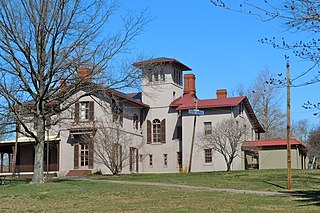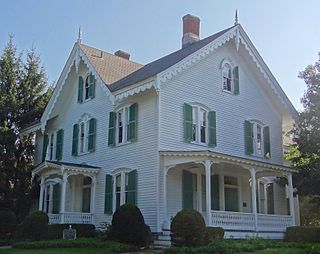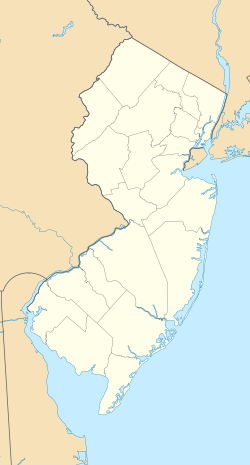
Maybury Hill is a historic house at 346 Snowden Lane, in Princeton, Mercer County, New Jersey, United States. Built about 1725, it was the birthplace and boyhood home of Joseph Hewes (1730-1779), a signer of the United States Declaration of Independence. The house, an architecturally excellent example of Georgian domestic architecture, was designated a National Historic Landmark in 1971 for its association with Hewes. It is a private residence not open to the public.

The William Trent House is a historic building located at 15 Market Street in Trenton, Mercer County, New Jersey. It was built in 1719 for William Trent and is the oldest building in Trenton. He founded the eponymous town, which became the capital of New Jersey. It has served as the residence for three Governors. The house was added to the National Register of Historic Places and listed as a National Historic Landmark on April 15, 1970, for its significance as an example of Early Georgian Colonial architecture.

The President's House, also known as the John Maclean House, or simply the Maclean House, in Princeton, Mercer County, New Jersey, United States, was built to serve as the home of the President of the College of New Jersey, which later became Princeton University. It was completed in 1756, the same year as Nassau Hall. United States Founding Father John Witherspoon lived here from 1768 through 1779, during which time he served as a delegate to the Continental Congress and signed the Declaration of Independence. George Washington occupied Maclean House in January 1777, during the Battle of Princeton and in 1783 while Congress met in Nassau Hall.

List of the National Register of Historic Places listings in Mercer County, New Jersey

The Howell Living History Farm, also known as the Joseph Phillips Farm, is a 130-acre (53 ha) living open-air museum located north of Titusville in the Pleasant Valley section of Hopewell Township in Mercer County, New Jersey. The farm was added to the National Register of Historic Places on May 2, 1977, for its significance in agriculture and architecture. The farm was included in the Pleasant Valley Historic District on June 14, 1991.

The Douglass House is a historic house at the corner of Front and Montgomery Streets in the Mill Hill neighborhood of the city Trenton in Mercer County, New Jersey. It served as George Washington's headquarters prior to the Battle of Princeton on January 3, 1777. Listed as the Bright–Douglass House, it was documented by the Historic American Buildings Survey in 1936, when the house was located in Mahlon Stacy Park near the Delaware River. It was added to the National Register of Historic Places on December 18, 1970, for its significance in architecture, military and social history. It was added as a contributing property to the Mill Hill Historic District on December 12, 1977.

The Demarest–Bloomer–Hart House, also known as the Demarest–Bloomer House, is located at 147 River Edge Avenue in the borough of New Milford in Bergen County, New Jersey, United States. The historic Greek Revival house was added to the National Register of Historic Places on November 7, 1985, for its significance in architecture.

The Haring–Vervalen House was located at 200 Tappan Road in the borough of Norwood in Bergen County, New Jersey, United States. The historic stone house was built around 1757 based on history and architectural evidence. It was added to the National Register of Historic Places on January 10, 1983, for its significance in architecture. It was listed as part of the Early Stone Houses of Bergen County Multiple Property Submission (MPS). It was demolished in 2013.

The Westervelt–Cameron House is located at 26 East Glen Avenue in the village of Ridgewood in Bergen County, New Jersey, United States. The house was built around 1767 and was added to the National Register of Historic Places on January 10, 1983, for its significance in architecture and exploration/settlement. It was listed as part of the Early Stone Houses of Bergen County Multiple Property Submission (MPS).

The Mansion House is a historic residence located in Cadwalader Park in the city of Trenton in Mercer County, New Jersey, United States. The house was built as a summer residence for Henry McCall Sr. of Philadelphia in 1848, and is one of the earliest examples of Italianate architecture in the United States. The building was added to the National Register of Historic Places on February 6, 1973, for its significance in architecture and landscape architecture.

The Stephen Condit House is a historic farmhouse located on Beverwyck Road in the township of Parsippany–Troy Hills in Morris County, New Jersey, United States. Built around 1870, it was added to the National Register of Historic Places on February 15, 1974, for its significance in architecture and community history.

The Mountain Avenue Historic District is a stretch of historic houses on Mountain Avenue in Princeton, New Jersey that date to the 19th and early 20th centuries. The 9-acre (3.6 ha) historic district was added to the National Register of Historic Places on February 2, 1995, for its significance in architecture and community planning. It includes 14 contributing buildings, and encompasses the north side of the road between the west side of the Mountain Lakes Preserve and Quarry Lane.

The John Abbott II House is located at 2200 Kuser Road in Hamilton Township of Mercer County, New Jersey. It was built c. 1730. The house is currently used as a museum by the Historical Society of Hamilton Township and is open to the public. It was added to the National Register of Historic Places on June 18, 1976, for its significance in architecture, military history, and politics/government.

The John D. Hart House is a historic home built c. 1800 and located at 54 East Curlis Avenue in Hopewell Township near the borough of Pennington in Mercer County, New Jersey. It was documented by the Historic American Buildings Survey in 1937. The house was added to the National Register of Historic Places on October 18, 1972, for its significance in architecture.

The Jeremiah Woolsey House is a historic Dutch Colonial home located at 237 Washington Crossing–Pennington Road, southwest of Pennington, in Hopewell Township of Mercer County, New Jersey. Listed as the Jeremiah M. Woolsey House, it was documented by the Historic American Buildings Survey in 1936. The house was added to the National Register of Historic Places on January 27, 1975, for its significance in architecture and politics/government.

The John Welling House is a historic Dutch Colonial home in Pennington, New Jersey that dates to the early 18th century. John Welling moved to the Hopewell valley from Jamaica, New York in 1727 and leased the home and 223 acres (90 ha) farm from Terit Lester, purchasing it the next year. A tradition exists that during the British occupation of Pennington during the American Revolution a Hessian soldier was taken captive in the home. Welling's great-granddaughter, Elizabeth Welling, married John D. Hart who built the adjacent John D. Hart House, which is also on the National Register of Historic Places (NRHP). The home remained in the Welling family until 1921 and from 1928 until 1973 was home to Congressman Charles R. Howell. The house is a rare example of a Dutch clapboard and shingle house, one of the few remaining in Mercer County. It was documented by the Historic American Buildings Survey (HABS) in 1937 and was added to the NRHP on March 14, 1973, for its significance in architecture.

The Dr. John Vermeule House, also known as the Vermeule–Mundy House, is a historic building located at 223 Rock Avenue in Green Brook Township of Somerset County, New Jersey. It was added to the National Register of Historic Places on February 20, 2013, for its significance in architecture.

The John White House is a historic stone house built around 1800 and located on Cold Soil Road north of the Lawrenceville section of Lawrence Township in Mercer County, New Jersey, United States. Featuring Federal architecture, the house was added to the National Register of Historic Places on January 29, 1973, for its significance in architecture. John White purchased a plot of 231 acres (93 ha) here in 1793. According to the nomination form, the house displays excellent workmanship and is in a well-preserved state.

The Old Ryan Farm, also known as the Benjamin Temple House and the Temple–Ryan Farmhouse, is a historic house built c. 1750 and located at 27 Federal City Road in the Ewingville section of Ewing Township in Mercer County, New Jersey, United States. It was added to the National Register of Historic Places on September 10, 1971, for its significance in agriculture and architecture. The house was moved from its original location on Pennington Road in May 1973. The Benjamin Temple House is now operated as a historic house museum by the Ewing Township Historic Preservation Society.

The David and Cornelius Van Horn House is located at 11 Cedar Lane in the borough of Closter in Bergen County, New Jersey, United States The historic stone house was built around 1778 and was added to the National Register of Historic Places on January 9, 1983, for its significance in architecture. It was listed as part of the Early Stone Houses of Bergen County Multiple Property Submission (MPS).
























